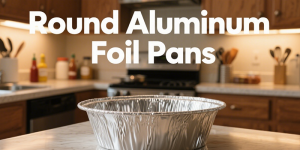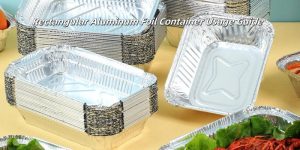Lots of people use aluminum foil pans to warm up food because they are easy to use, clean, and help heat food evenly.
Some people worry about using aluminum foil in the microwave. It can react with metal and microwaves. This may cause sparks or even fires. Is it safe to microwave aluminum foil containers?
Why Microwaving Aluminum Foil Containers Is Generally Unsafe
Microwaves heat food by exciting water molecules using electromagnetic waves (2.45 GHz frequency). Aluminum foil, being a conductive metal, reflects these waves, creating two primary hazards:
- Arcing: When foil edges or wrinkles create concentrated electric fields, sparks can ignite fires. Even small foil pieces (≥0.5 inches) risk arcing.
- Uneven Heating: Shielded areas under foil stay cold, while exposed zones overheat, promoting bacterial growth (e.g., Salmonella in partially heated chicken).
A 2021 Journal of Food Engineering study found that crumpled foil in microwaves generated temperatures exceeding 1,472°F (800°C), enough to melt glass.
The FDA explicitly warns against microwaving metal containers unless they’re labeled “microwave-safe” and follow strict design rules.
How Microwave Ovens Work
The working principle of a microwave oven is based on the principles of microwaves and molecular vibration. A microwave is a kind of electromagnetic wave; its frequency is usually around 2.45 GHz. Microwave ovens create electromagnetic waves using a magnetron, which travel through a metal waveguide inside the oven. When food encounters these electromagnetic waves, water molecules in the food absorb them.

When food absorbs microwave radiation, water molecules vibrate. This vibration causes the temperature of the food to rise because of the friction between these molecules. Microwaves heat food by absorbing water molecules, so a microwave can only heat food with moisture.
Microwave ovens use magnetrons to generate microwave radiation. It has a cathode and an anode. Electrons pass through a magnetic field and create a ray. This ray travels through a waveguide and produces microwave radiation.
The microwave oven has a reflector that bounces microwaves back inside to evenly heat the food. Microwave ovens have a turntable that helps heat food by rotating it in the microwave radiation.
Is It Safe To Use Foil Dishes In The Microwave
Aluminum foil trays can withstand temperatures up to 240 °C. They heat food evenly and are safe to use in the microwave. This is because they have good thermal conduction. When using foil containers, do not use lids, and do not heat them in a sealed container.
You must evenly spread the food inside the container, filling at least 80% of the plate’s capacity. Place the aluminum foil container in the middle of the turntable of the microwave oven.
If your microwave has a metal turntable, put a ceramic or glass mat under the aluminum foil box. Set the heating time, and the microwave oven will sound a notification when the time is up. Remember to wear gloves when taking it out to avoid burns.
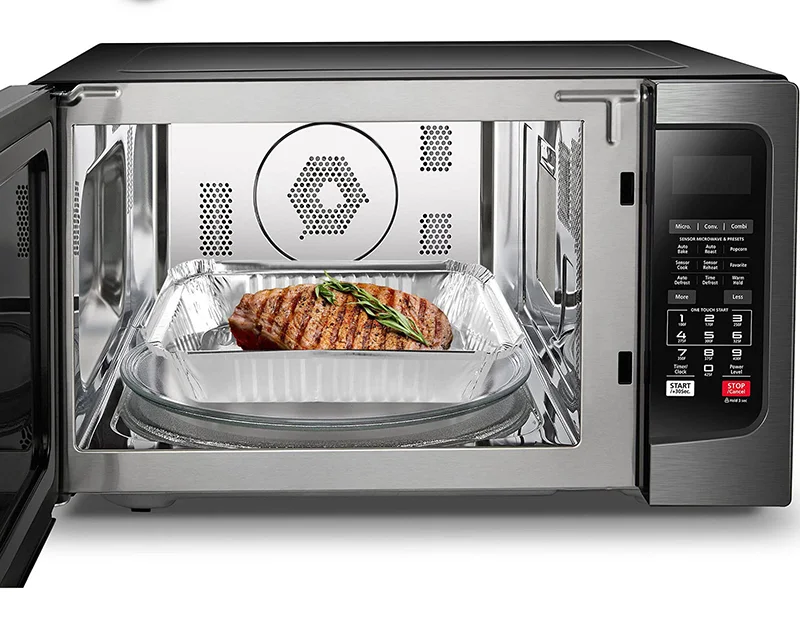
Can Aluminum Foil Containers Be Microwaved
FDA-Approved Designs: Look for shallow, smooth-edge trays with a microwave-safe symbol (wavy lines). These use micro-thin foil (≤0.001 inches) laminated to paper/plastic, preventing arcing. Cover only 1/3 of the food with flat, smooth foil to shield edges (e.g., turkey legs) while allowing steam venting.
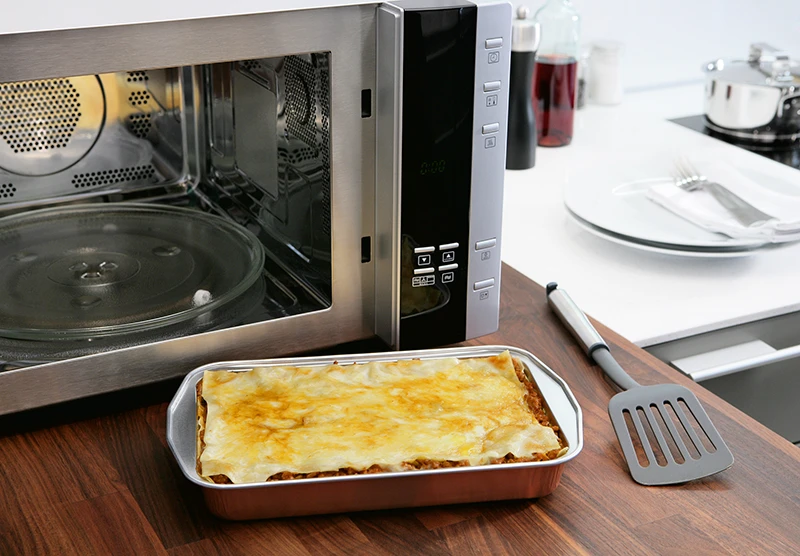
Some aluminum foil containers are microwave-safe because they have a coated outside. Aluminum foil lunch boxes can cause sparks and damage the microwave if put inside them. This is because they contain materials like iron, aluminum, stainless steel, and enamel, which react with microwaves.
Best to avoid putting these types of lunch boxes in the microwave. Sparks can be dangerous and damage the oven. This is because they contain iron, aluminum, stainless steel, enamel, or other materials that react with microwaves. Also heat uncooked food.
Furthermore, you cannot place ordinary plastic containers in the microwave oven. Ordinary plastics will release toxic substances, contaminate food, and endanger human health. You should use special microwave containers to hold and heat food in the microwave oven.
When using an aluminum foil lunch box in a microwave, make sure to check the microwave’s condition first.
Safe Use Of Microwave Ovens
Be cautious with aluminum in the microwave; it can cause fires or damage the microwave from reflecting microwaves. If you must use aluminum products to cook or heat food, consider the following suggestions:
- Use aluminum products in the microwave by themselves, without other metal items or aluminum foil.
- Don’t put large or pointed aluminum items in the microwave. They can make the microwaves bounce around and damage the microwave. Stick to smaller, regular-shaped items instead.
- Avoid using aluminum products for cooking in the microwave, as they prevent the microwaves from fully heating the food.
To use aluminum foil containers in the microwave, here are some safety tips:
- Aluminum foil lunch boxes for microwaves should not have metal decorations or packaging. This is to prevent fires or damage to the microwave. Metal in the microwave can cause fires or damage. Avoiding metal in the microwave is important to keep it safe.
- When heating food in an aluminum foil lunch box, cover the food with the lid. Avoid touching the foil directly to prevent a reaction with acidic substances in the food.
- You should only use aluminum foil lunch boxes for microwaving food, not for cooking or storing other types of food.
- Never heat at high temperatures for a long time to avoid fire or burning.
What Is Microwavable Aluminum Foil Trays
Microwavable aluminum trays are containers made of aluminum foil that are safe to use in the microwave. Aluminum foil conducts heat well. In a microwave, it absorbs and reflects microwaves, affecting how food cooks.
In this way, the tray wraps the food, and the microwaves heat the food through the foil surrounding it. Aluminum foil trays also help distribute heat evenly, so that food heats up quickly and evenly. Microwavable aluminum trays clearly mark as microwave-safe and safe to use.
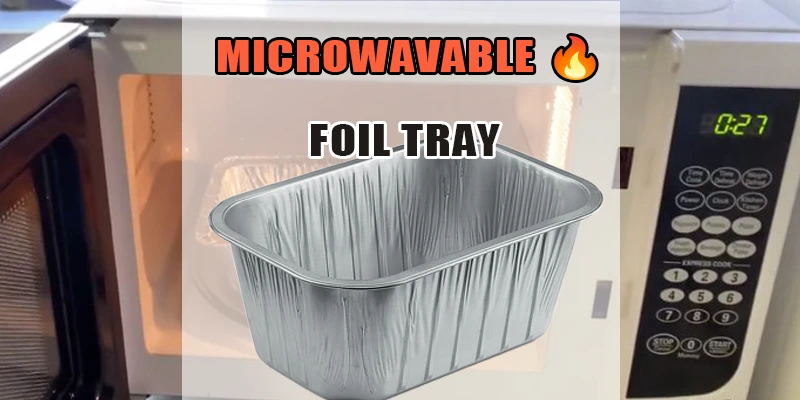
Commercial and Household Usage
Commercial Food Businesses
Prioritize Use containers explicitly labeled “microwave-safe” by manufacturers to avoid fire hazards or food contamination. Aluminum foil containers with rounded, burr-free edges to minimize arcing (sparks) in microwaves. It ensures containers can withstand high temperatures without warping or leaching chemicals.
You should avoid fully sealing foil lids—leave a small vent to release steam and prevent uneven heating. Place a microwave-safe paper towel between the foil container and food to absorb excess moisture and reduce splatter.
Household Usages
Never let aluminum foil touch microwave walls or other metal objects. Limit microwaving to 1–2 minutes at medium power (50–70%) to reduce arcing risks. Use small, flat foil pieces to cover specific food areas (e.g., chicken wings) without crumpling edges.
Reuse crumpled or damaged foil containers.
Microwave empty foil containers (risk of fire).
Use foil in combination with high-fat foods (e.g., bacon), as grease can overheat and ignite.
Troubleshooting Common Issues
Consequences Of Placing Foil Containers in the Microwave
Aluminum foil pans are metal products that may cause sparks when exposed to electromagnetic waves generated in microwave ovens. This is because metal reflects microwaves and generates electric current. When the electric current is too large, it may produce sparks or even cause a fire.
The presence of metal can cause damage to the interior of the microwave. Sparks in your microwave can damage important parts like magnetrons and fuses. Because aluminum foil reflects microwaves, it interferes with the propagation and absorption of microwaves, causing uneven heating of food.
Some aluminum foil lunch boxes have wrinkled edges, which can trap microwave electrons and cause sparks quickly.
What Materials Can Be Put In The Microwave
- Glass Containers: Glass containers are transparent and you can easily monitor cooking. Glass also does not react and will not leak harmful substances into food, making it a safe choice.
- Ceramic Ware: Ceramic bowls, plates and other ceramic ware are common microwave-safe containers. They can ensure even heating and good heat retention.
- Plastic Containers: Choose plastic containers marked “Microwave safe.” You should use plastic containers specifically designed for microwave use.
- Special Microwave-Friendly Food Covers: Microwave-safe food covers help heat food evenly in the microwave.
- Food: You can heat most foods directly in the microwave. Make sure to arrange food to avoid overheating or burning.
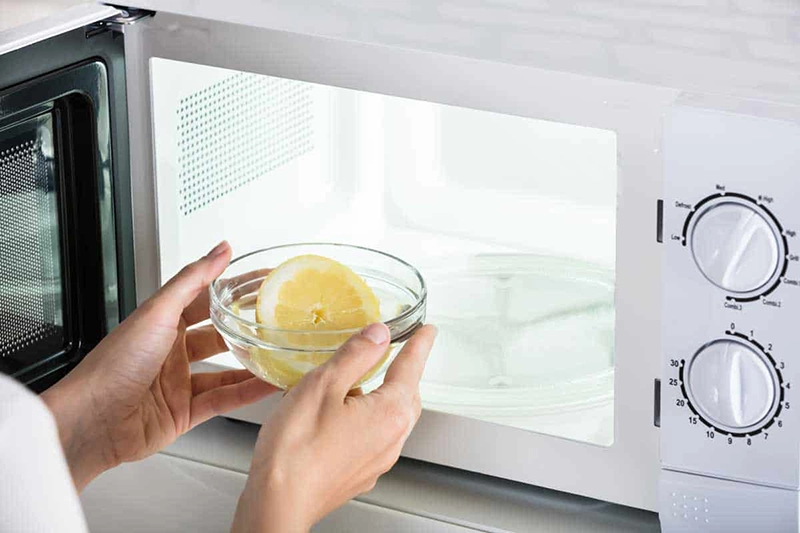
How to Identify Truly Microwave-Safe Aluminum Containers
Legitimate microwave-safe foil products meet these criteria:
- Smooth, Rounded Edges: No sharp corners to concentrate electric fields.
- Non-Reactive Coating: Ceramic or polymer layers prevent aluminum-food contact.
- Third-Party Certification: Look for UL, NSF, or IEC 60335-2-25 compliance marks.
Brand Examples:
- Packit Gourmet: Laminated foil pouches for camping meals.
- Cuisine Solutions: Sous-vide trays with microwave-safe seals.
When Is Microwaving Foil Safe
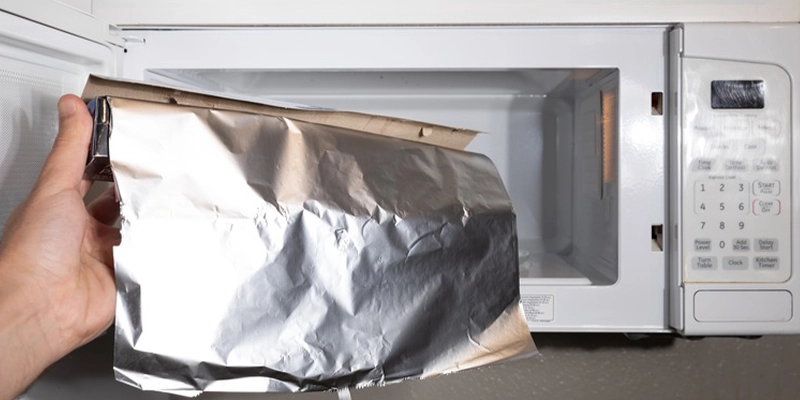
The FDA permits minimal, flat foil use under strict conditions:
Smooth, Unwrinkled Sheets Only:
- Maximum size: 2″ x 2″ (5x5cm).
- Must lie flat against container walls (never touching food).
Manufacturer-Approved Containers:
Some pre-packaged foods (e.g., frozen lasagnas) use FDA-certified “microwave-safe” foil trays with:
- Rounded edges to prevent arcing
- Protective paperboard sleeves
- Thickness ≥0.15mm to resist warping
What to Do If You’ve Accidentally Microwaved Foil
- Stop Immediately: Press cancel and unplug the microwave.
- Inspect for Damage: Look for melted spots or magnetron odors.
- Ventilate: Open windows to disperse ozone (produced during arcing).
- Test Functionality: Heat a water cup for 1 minute—if uneven, repair or replace.
Top Microwave-Safe Alternatives to Aluminum Foil Containers
For worry-free reheating, follow these options:
| Material | Max Temp | Pros | Cons |
| Glass Containers | 932°F (500°C) | Non-reactive, easy to clean | Heavy, breakable |
| Ceramic | 572°F (300°C) | Retains heat, stylish | May crack with sudden temp changes |
| Silicone Lids | 428°F (220°C) | Flexible, airtight seal | Not oven-safe above 428°F |
| Parchment Paper | 420°F (215°C) | Biodegradable, non-stick | Limited reuse |
Pro Tip: For frozen meals, transfer food from foil trays to microwave-safe dishes.


